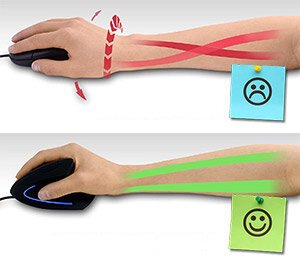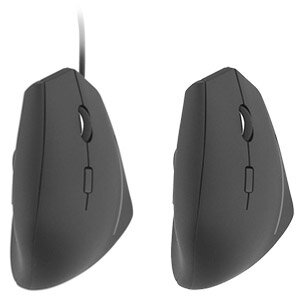€0.00 ex vat
Empty cart...
Discover our promotionsHow to choose an ergonomic vertical mouse? Buyer's guide
Are you looking for an ergonomic mouse? You've come to the right place! Shape, size, grip, tilt, weight... We go through all the buying criteria to help you make the right choice.
Contents
1 Ergonomic mouse: definition
2 Why use an ergonomic mouse?
3 Do you need a vertical mouse for your right or left hand?
4 Do you have a large or small hand size?
5 Vertical mouse: what is the ideal grip angle?
6 Are the buttons on the ergonomic mouse customisable?
7 Wired or wireless mouse: which one should you choose?
8 Weight: light or heavy mouse?
9 Ergonomic mouse: what budget?
1 - Ergonomic mouse: definition
An ergonomic mouse is a computer mouse that adapts to the user's natural posture. There are many types of ergonomic mice: vertical mice, trackball mice, central mice... This buying guide focuses on the selection criteria for vertical mice.
2 - Why use an ergonomic mouse?
The advantage of an ergonomic mouse is primarily a physical one.
- With a conventional mouse, the position of the forearm compresses the median nerve, which very often triggers carpal tunnel syndrome with tingling, loss of sensitivity, loss of strength in the hand...
- With an ergonomic mouse, the forearm is in a natural and comfortable position. The wrist is not twisted: the median nerve is not compressed.
An ergonomic mouse therefore helps to avoid musculoskeletal disorders, which are unfortunately often caused by regular use of a classical mouse. However, in order to make the right choice, you must ask yourself the right questions.
- With a conventional mouse, the position of the forearm compresses the median nerve, which very often triggers carpal tunnel syndrome with tingling, loss of sensitivity, loss of strength in the hand...
- With an ergonomic mouse, the forearm is in a natural and comfortable position. The wrist is not twisted: the median nerve is not compressed.
An ergonomic mouse therefore helps to avoid musculoskeletal disorders, which are unfortunately often caused by regular use of a classical mouse. However, in order to make the right choice, you must ask yourself the right questions.

3 - Do you need a vertical mouse for your right or left hand?
This is the first question to ask. Of course, there are mice for right-handed and left-handed users, and it is simply not possible to use a right-handed mouse with the left hand. Be careful!
4 - Do you have a large or small hand size?
A mouse is only ergonomic if it fits the user's hand size. Some manufacturers make their mice in different sizes. To help you find out whether the size suits you, compare it with the size of your current mouse. Note that while "small" mice are handy for accompanying a laptop, they tend not to support the palm of the hand, which is not at all ergonomic.
5 - Vertical mouse: what is the ideal grip angle?

A little definition as a reminder: the grip angle of a computer mouse is the angle between the desk and the hand. When you place your hand on a vertical mouse, you should not feel any muscle or joint pressure: the fingers should remain naturally flexible, neither too tight nor too widely spread.
- - Traditional mice have a 0° grip angle. This means that the palm is parallel to the desk.
- - Semi-vertical mice have a 25° grip angle. They are not completely vertical yet, but already offer more comfort and ergonomics by orienting the palm inwards. Inclined mice are a good compromise to relieve wrist strain without disturbing the user's habits too much.
- - Vertical mice have a grip angle of almost 90°. This design offers an optimal wrist position. The inward-facing palm allows the hand to rest naturally. It takes a little time to get used to them, but vertical mice are the most effective ergonomic models to counter musculoskeletal disorders (MSD).
6 - Are the buttons on the ergonomic mouse customisable?
Mouse wheel, click buttons, extra buttons... Ergonomics also means being able to customise the mouse keys according to the user's preferences and habits. Some computer mice allow you to program their keys with the actions you want in a few clicks. This makes it possible to gain in speed and comfort at the same time.
7 - Wired or wireless mouse: which one should you choose?
Wired or wireless computer mice: both have their pros and cons! The choice should be made according to your preferences...
- A wired mouse
- Advantage: no need to recharge it!
- Disadvantage: unattractive and impractical cable.
- A wireless mouse
- Advantages: no wires lying around on the desk (it works with Bluetooth or with a USB receiver), easy to take with you to meetings or appointments;
- Disadvantages: battery charging, often heavier weight.

8 - Weight: light or heavy mouse?
Some professionals use their computer mouse intensively (computer graphic designers, for example). If this is your case, the weight of an ergonomic or non-ergonomic mouse should also be taken into account when making your purchase. You should choose a lightweight mouse, as a mouse that is too heavy can - without seeming to - tire your hand and wrist. Remember that wireless mice are often heavier because of the weight of the batteries...
9 - Ergonomic mouse: what budget?
Obviously, prices can vary from one brand to another, but in general, you can expect to pay an average of €40 for a vertical mouse. A modest sum compared to the osteopathic or physiotherapist fees generated by musculoskeletal disorders. ;)That's it! You now know the most important criteria to take into account when choosing an ergonomic mouse. Now it's up to you to choose yours!